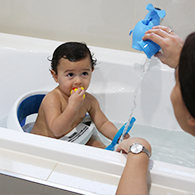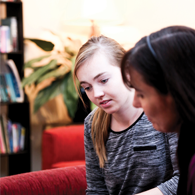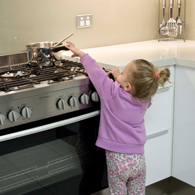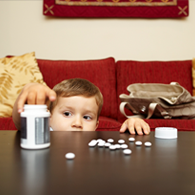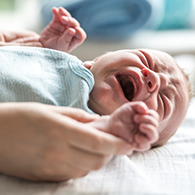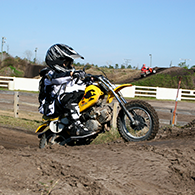Bicycles and helmets
What are bicycles and helmets?
Bicycles are two wheeled vehicles with a frame, a saddle on which the rider sits, handlebars for steering and are propelled using human power on foot pedals.
Helmets are safety devices worn by riders to protect the head in the event of a crash or impact. They can prevent or lessen the severity of brain injury resulting from a crash. Helmets are typically made of rigid crushable foam covered by a thin layer of plastic and are held to the head by the use of flexible straps and hardware. Helmets work by absorbing some of the energy from a crash and spreading it over a larger area for a slightly longer time.
How are children injured?
Cycling is a popular form of transport and is also a healthy and enjoyable outdoor activity for children. As with most activities, cycling has the potential to cause injury to the rider, with head injuries being the most common cause of serious disability and fatality.
Falls
- Children may lose control of the bicycle and fall off.
- Children may also lose control as a result of external factors such as the appearance of a sudden/unexpected obstacle in their riding path. As they swerve to avoid the obstacle, they may crash into another vehicle or a fixed object and as a result, sustain a fall.
Cuts, bruises and friction burns
- Children may sustain cuts, bruises and/or friction burns as a result of a crash.
How common are these injuries?
In Australia, over a ten year period, 37,382 children aged 0-16 years were admitted to hospital for injuries sustained while cycling.1 In 2016-2017, 182 children were admitted to the Sydney Children’s Hospitals Network for pedal cycle injuries.2
What are the laws, regulations or standards for bicycles and helmets?
Bicycles:
The law states that bicycles sold in Australia must comply with the Australian Standard (AS/NZS 1927 - Pedal bicycles - Safety requirements).
Helmets:
In 1991, the bicycle helmet legislation was introduced in NSW making it mandatory for all riders to wear helmets while riding a bicycle.
The Trade Practices (Consumer Product Safety Standard) (Bicycle Helmets) Amendment Regulations 2001 (including SLI NO 390 of 2009) states that all helmets for pedal cyclists sold in Australia must comply with the Australian Standard (AS/NZS 2063 - Bicycle helmets).
For further information please visit Product Safety | Bicycle Helmets
Riding:
The law in NSW states that children under the age of 16 and accompanying adult riders may use the footpath for cycling, excluding footpaths with signs prohibiting cycling. Riders are to keep to the left and give way to pedestrians.
The law also states that children 16 years and older must not ride on footpaths unless they are accompanying and supervising a child under 16 years of age.
Cyclists riding on the road must keep to the left and use marked bicycle lanes when possible. All bicycles must be fitted with a working brake and a bell and may be fitted with power assistance up to 200W. If a bicycle is to be used at night, it must have front and rear lights and a rear reflector.
Remember:
- A bicycle needs to be the right size for your child. Here are some key points:
- When your child is seated with hands on the handlebar, they must be able to place both feet flat on the ground.
- When they are standing above the horizontal crossbar with both feet flat on the ground, the distance between the bar and your child’s crotch should be 3 cm.
- Make sure that while in the riding position, your child can comfortably grasp the brakes and apply the pressure needed to stop the bicycle.
- Regularly maintain your child’s bicycle, ensuring that the wheels are in good order and the tyres properly inflated. Test the brakes, gears, chain, pedals, lights, reflectors and like parts. You can also check the Bicycle Rider Handbook at Roads & Maritime Services NSW for further information.
- If you are obtaining a second-hand bicycle for your child, be sure to check all parts of the vehicle prior to your child riding it.
- It is the law to wear a Standards Australia approved helmet when riding a bicycle. At the time of your bicycle purchase, also remember to get your child fitted for a helmet. Helmets come in a variety of styles and sizes to suit individuals.
- Helmets should be positioned on the head to sit low on the forehead and parallel to the ground when the head is held upright. It should not be pulled low over the forehead or tilted back on the crown. Once adjusted by installation or removal of inside pads, the strap should fit comfortably with very little movement either side (tight with room for only 2 fingers to be inserted between the strap and the chin).
- Replace your child’s helmet if it sustains a substantial blow or is involved in a crash resulting in scratches to the shell. It is also safe practice to replace your child’s helmet every five years (or sooner if the manufacturer recommends it), even if it has not been involved in a crash.
- Avoid the use of second-hand helmets, especially if you are unsure of the age of the helmet or if it has been involved in a previous crash.
- Make sure your child wears closed-in shoes and comfortable close fitting clothing to reduce the risk of loose items getting caught in the chain or wheels of the bicycle. Light coloured or reflective clothing is preferred, especially at night, so that your child may be easily spotted by an approaching vehicle.
- Lights must be used when riding at night time to increase visibility.
References
1 Mitchell R, Curtis K, Foster K. A 10 year review of the characteristics and health outcomes fo injury-related hospitalisations of children in Australia. Day of Difference Foundation. University of Sydney. 5th May 2017.
2 Kids Health Child Health Promotion Unit, Injury-related hospital admissions to Sydney Children’s Hospitals Network (2016-2017). Sydney Children’s Hopsitals Network. 2019.
